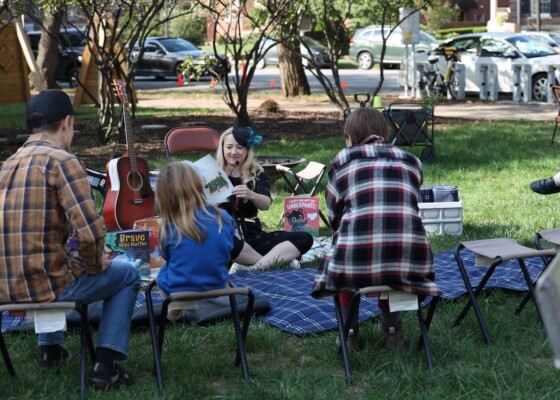Approaching the Sacred at Prophetstown
November 1, 2016I am grateful to everyone involved in Indiana Humanities’ Next Indiana Campfire bicentennial program for the grounding and uplifting experience given a group of us at Prophetstown State Park near West…
I am grateful to everyone involved in Indiana Humanities’ Next Indiana Campfire bicentennial program for the grounding and uplifting experience given a group of us at Prophetstown State Park near West Lafayette on August 5, 2016. Thanks especially to Leah Nahmias, Director of Programs and Community Engagement at Indiana Humanities, for the invitation to write this essay.
I enjoyed hearing Indiana Poet Laureate Shari Wagner introduce and read various poems and prose excerpts, including Mvskoke Joy Harjo’s “Eagle Poem,” one of my all-time favorite prayer-poems. It begins: “To pray you open your whole self / To sky, to earth, to sun, to moon / To one whole voice that is you.” Also memorable was a passage from Kiowa N. Scott Momaday’s essay “An American Land Ethic,” in which he states, “At Devil’s Tower or Canyon de Chelly or the Cahokia Mounds you touch the pulse of the living planet; you feel its breath upon you. You become one with a spirit that pervades geologic time, that indeed confounds time and space.”
It was a highlight to read with Shari, as a call and response, Momaday’s “The Delight Song of Tsoaitalee,” a list, litany, and naming poem with these lines near the end: “You see, I am alive, I am alive / I stand in good relation to the earth / I stand in good relation to the gods / I stand in good relation to all that is beautiful.” Both the Shawnee visionary Tecumseh’s words to General William Henry Harrison (1810), “Sell a country! Why not sell the air, great sea, as well as the earth,” and Potawatomi Chief Simon Pokagon’s lament on the loss of the wild pigeon, “I have stood by the grandest waterfall in America and regarded the descending torrents in wonder and astonishment, yet never have my astonishment, wonder, and admiration been so stirred as when I have witnessed these birds drop from their course like meteors from heaven,” were and remain haunting.
As someone who grew up in southern Indiana as a devotee of hills and woods, I especially enjoyed walking the prairie and looking, listening and seeing many “new” wildflowers, grasses, birds, tree lines, clouds and sky. Walking in the prairie landscape where many Native nations once lived in community with the visionary leader Tecumseh and his brother Tenskwatawa, The Prophet, was a new experience for me. It made me feel closer and more connected to the history and culture of this place we later arrivals call Indiana.
It is always instructive and inspirational to have an experience in which the beauty of wildflowers, plants, herbs, birds, and mammals unfamiliar to us present themselves to us. New forms of life we see close-up for the first time expand our inner landscape and enlarge our awareness and spiritual connectedness. It is uplifting to look, listen, and receive, because the more we give of ourselves, the more the landscape and its flora and fauna present to us. We grow and expand our consciousness and spirituality as we train our eyes and ears and expand our capacity to perceive what is around us. As we open ourselves to this beauty, we tune in to a microcosm that makes the world of our awareness larger and deeper. As Momaday tells us, “To encounter the sacred is to be alive at the deepest center of human existence.” At Prophetstown State Park, so quiet, removed, and serene in the evening, I sensed that I was approaching the presence of the sacred.
Here is a poem I drafted shortly after that evening of epiphany at Prophetstown. I reflect on the sense I had of seeing some of the older prairie plants flourishing again at the site. It was frustrating not being able to name many of these beautiful wildflowers because I had not seen them before. Naming is an important tradition in Native American poetry as a way of praising what is sacred. How can we speak in our “whole voice ” and fully pray, to echo Joy Harjo, if we cannot name what we love?
Walking Prairie Being Reclaimed
-at Prophetstown-
Once in the evening I walked a trail
through wildflowers flourishing
where the old prairie was allowed
and encouraged to return in full.
We walked and stopped to look
and asked for the names of stunning
flowers we loved but could not fully
register without saying their names.
Robert Bly once said in a prose poem
“We cannot remain in love with what
we cannot name.” And so we stood
there in the face of beauty unnamed
feeling better for being in the presence
of what we loved but could not always
address. We were back in the presence
of spiritual beings we once revered
but could not fully summon because
their names were not on our tongues.
We felt uplifted but not fulfilled
as we walked into rays of moonlight
but even our inability to name did
not diminish in the thickening dusk
the wild beauty of a love returning
as we grew more rooted in the past.
© 2016 Norbert Krapf
—————————————————-
Next Indiana Campfires is a unique way to connect nature, literature and Indiana’s Bicentennial. The program is supported by the Efroymson Family Fund, the Nina Mason Pulliam Charitable Trust and Pulitzer Prizes Centennial Campfires. Indiana Humanities is supported in part by Lilly Endowment Inc. and the National Endowment of the Humanities.
This post was written by Norbert Krapf and is part of the weekly blog series devoted to the initiative. Check back every Tuesday to learn more about Indiana’s great environmental literature, find out interesting facts about Hoosier stewardship, get all the latest program details and more.


